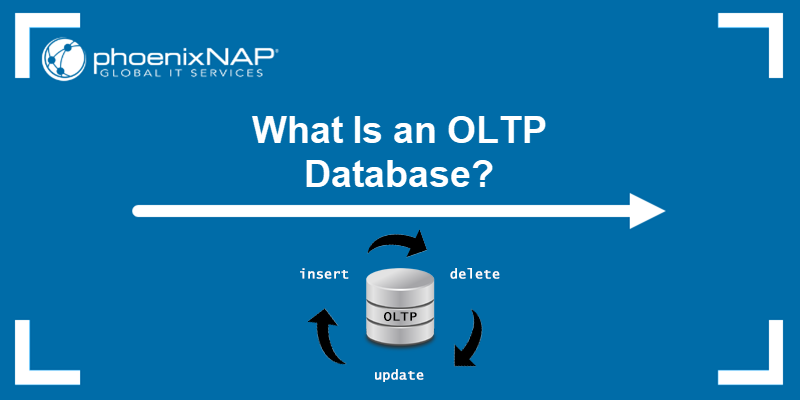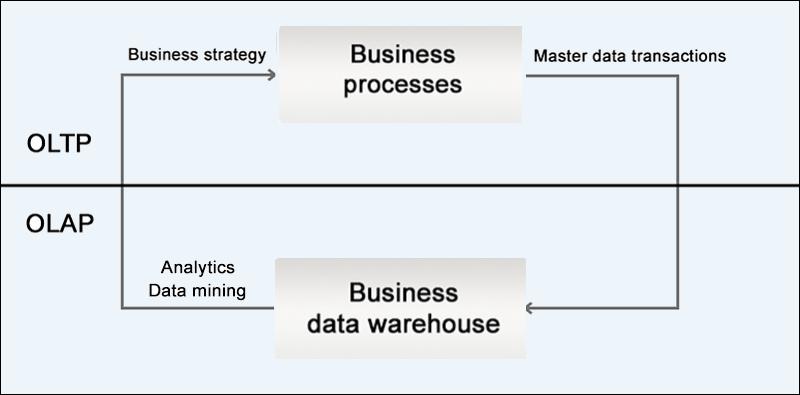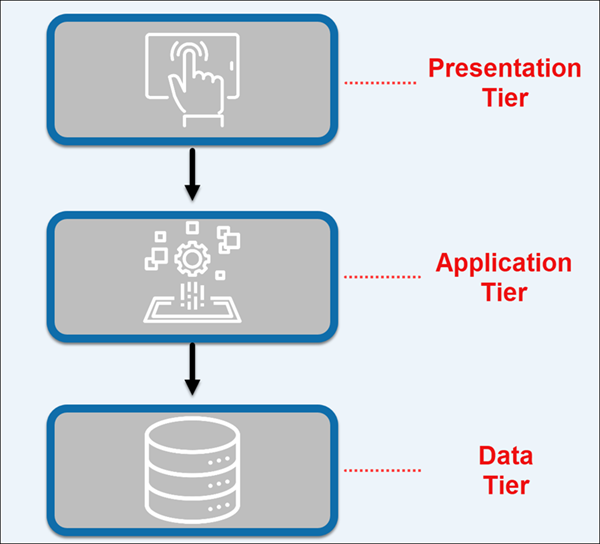Introduction
Online Transaction Processing (OLTP) databases are designed to handle a high volume of real-time transactions from multiple users. They are essential for managing day-to-day operations that involve inserting, updating, and deleting data.
This article explores the key features, advantages, and disadvantages of OLTP databases, along with a comparison to Online Analytical Processing (OLAP) systems.

What Is an OLTP Database?
An OLTP database stores and manages data related to an organization's day-to-day operations. It focuses on handling transaction-oriented tasks efficiently.
OLTP databases process high volumes of short transactions such as inserting, updating, or deleting data. They prioritize data integrity, speed, and consistency to ensure smooth operations, even when managing multiple transactions simultaneously.
OLTP vs. OLAP
OLTP and OLAP are two systems that complement each other. While OLTP deals with processing day-to-day transactions, OLAP helps analyze the processed data.
Here are some key differences between OLTP and OLAP:
| OLTP | OLAP |
|---|---|
| Administers day-to-day transactions of an organization. | Performs business analyses, including planning, budgeting, forecasting, data mining, etc. |
| Emphasizes fast query processing and ensures data integrity in multi-access environments. | Emphasizes the response time to executing complex queries on large amounts of historical data aggregated from many rows. |
Deals with standard and straightforward queries (e.g., insert, delete, and update statements). | Deals with complex queries that involve a lot of data (for example, aggregate queries). Mainly uses the select statement. |
| End users are clerks, cashiers, DBA, etc. | End users are knowledge workers, business analysts, managers, etc. |
| Stores data in 3NF (third normal form). | Denormalizes data to improve query performance. |
| Doesn't take up much space. | Usually takes up a lot of space. |
| Regularly performs data backups. | Rarely performs data backups. |
| Utilizes an ER model schema. | Utilizes a snowflake schema. |
| Uses traditional DBMS. | Uses a unique data warehouse that integrates different sources. |
| Market-oriented. | Customer oriented. |
| Designed for real-time business operations. | Designed for analyzing business measures by category and attributes. |
| Supports thousands of users. | Supports hundreds of users. |
Note: Third Normal Form (3NF) is a database schema design for relational databases. 3NF uses normalizing principles to reduce data duplication, prevent data anomalies, secure data integrity, and simplify data management.
The following diagram shows the connection between OLTP and OLAP:

OLTP Features
OLTP databases can handle a large number of concurrent transactions while ensuring data consistency and reliability.
Below are the key features that make OLTP systems efficient:
- Handling transactions that involve small data amounts. Optimized for quick, lightweight operations.
- Providing indexed access to data. Ensures faster access and retrieval to improve query performance.
- Support for a large number of users. Accommodates simultaneous access by multiple users.
- Processing frequent queries and updates. Designed for environments with constant read and write operations.
- Response times are measured in milliseconds. Provides real-time processing to meet business needs.
- Enabling real-time processing. Reflects real-world operations without delays.
- High availability and fault tolerance. Includes mechanisms to maintain uptime and recover from failures.
- Scaling for growth. Handles increased workloads as the number of users or transactions grows.
- Providing user authentication and security. Implements robust mechanisms to control access and protect sensitive data.
- Maintaining data consistency through ACID compliance. Adheres to Atomicity, Consistency, Isolation, and Durability principles for reliability.
OLTP Architecture
The OLTP system is based on a three-tier architecture, which organizes applications into three logical and physical tiers:
1. Presentation tier (User Interface). Provides the front-end interface for users to interact with the system, such as web applications or desktop applications.
2. Application tier (Data Processing). Handles business logic and processes transactions. This layer ensures data consistency and performs operations like querying, updating, and validating data.
3. Data Tier (Data Storage and Management). Stores and manages the data in a relational database. This tier is responsible for maintaining data integrity, executing queries, and ensuring high performance for read/write operations.

Each tier operates independently, with its own infrastructure, development lifecycle, and updates, ensuring modularity and scalability without affecting the other tiers.
OLTP Use Cases
OLTP database systems are commonly used for various short online transactions. They process queries and provide results almost instantly, ensuring real-time responsiveness for end-users.
Examples of using OLTP include:
- Performing online banking transactions. Account balances, funds transfers, or bill payments in real-time.
- Adding items to a shopping cart in webshops. Inventory and customer orders update as users select products.
- Booking tickets for travel or events. Seat availability, reservation confirmation, and payment details processing.
- Sending a text message. The message delivery status recording and updating communication logs.
- Entering orders in a sales system. Gathering customer details and product information and generating invoices.
- Withdrawing cash from an ATM. User credentials validation and account balance checks.
- Surveyors entering poll results. Survey data is stored in real-time for immediate analysis and reporting.
- Employees viewing and updating customer details. Customer records management, such as contact information or transaction history.
Popular OLTP Databases
Several databases are used for Online Transaction Processing (OLTP) due to their reliability, scalability, and ability to handle high transaction volumes. Below are the most popular OLTP databases, but also those that support both OLTP and OLAP:
- Oracle Database. A robust relational database known for its high performance, scalability, and advanced transaction management features. Used in enterprise applications across industries.
- MySQL. An open-source relational database that offers speed, reliability, and ease of use. Used for web applications and e-commerce platforms.
- Microsoft SQL Server. A relational database developed by Microsoft, known for its seamless integration with Windows environments and strong support for transactions.
Note: Learn how to install SQL server on Windows.
- PostgreSQL. An open-source database that combines powerful features with ACID compliance and extensibility. Popular for OLTP workloads in diverse industries.
Note: Learn how to connect to a PostgreSQL database from Windows or Linux.
- IBM Db2. A high-performance database designed for transactional and analytical workloads. Frequently used in enterprise-level applications.
- MariaDB. A community-developed fork of MySQL, offering enhanced performance and scalability for transactional operations.
Note: Learn how to install MariaDB on Ubuntu.
- Amazon Aurora. A cloud-based relational database service optimized for OLTP with high availability and auto-scaling features.
- SAP HANA. An in-memory database that delivers high-speed transactional processing and real-time analytics.
- SQLite. A lightweight, file-based database often used in embedded systems, mobile apps, and small-scale OLTP use cases.
- Google Cloud Spanner. A globally distributed database offering strong consistency and horizontal scalability, ideal for cloud-based OLTP applications.
OLTP Database Advantages and Disadvantages
Understanding the OLTP system's strengths and weaknesses helps businesses choose the right solution for their needs. The advantages and disadvantages are explained in detail in the following sections.
Advantages
OLTP databases provide fast, efficient transaction processing with high data consistency, making them ideal for real-time operations. Some key OLTP database advantages are:
- Integrating business processes. All business processes and transaction management needs are integrated into a single platform.
- Ensuring database consistency. A fully normalized schema maintains data consistency across the system.
- Applying security restrictions. Security controls on users and objects to protect sensitive data.
- Expanding the customer base. New customers are gained by simplifying and speeding up individual processes, enhancing user-friendliness.
- Modifying transactions in real-time. A stable foundation for businesses by enabling timely transaction modifications.
- Supporting large databases. Handling large-scale databases.
- Ensuring atomicity. Completing all transaction steps; if any step fails, the entire transaction is rolled back.
- Facilitating data manipulation. Easy data manipulation through techniques like data partitioning.
Disadvantages
While OLTP databases offer fast transaction processing, they face challenges like scalability issues and high resource consumption under heavy loads. The following list elaborates on some disadvantages:
- High staff dependency. IT professionals and business staff are needed to implement, manage, and maintain OLTP database systems.
- Storage of sensitive information. Holds user data and account details, which necessitates high-level security to protect sensitive data.
- Risk of data loss. Transactions are vulnerable to hardware failures, with server issues potentially causing significant data loss.
- Concurrent data modifications are allowed. Multiple users can access and modify the same data concurrently, which leads to data consistency issues.
- Support for limited query volume. Restriction of the number of queries and updates, which becomes a bottleneck during high traffic.
- Prone to scalability issues. Challenging to scale as transaction volumes increase in dynamic environments.
- High resource consumption. Significant CPU and memory usage under heavy loads impact overall system performance.
OLTP Best Practices for Implementation
Implementing an OLTP system requires careful planning and adherence to best practices to ensure optimal performance, data consistency, and scalability. Below are some of the best practices for effective OLTP implementation:
- Designing a normalized schema. Use a fully normalized database schema to eliminate data redundancy and maintain consistency.
- Implementing efficient indexing. Create indexes on frequently queried columns to improve query performance and reduce response time.
- Ensuring strong security measures. Apply robust security controls, such as encryption, authentication, and access control, to protect sensitive data.
- Using ACID-compliant transactions. Ensure the database supports Atomicity, Consistency, Isolation, and Durability to maintain reliable transaction processing.
- Optimizing query performance. Regularly analyze and optimize SQL queries to prevent slowdowns and reduce resource usage.
- Partitioning large tables. Split large tables into smaller partitions to improve data management and query performance.
- Configuring backup and recovery solutions. Implement automated backups and disaster recovery plans to prevent data loss in case of failures.
- Monitoring database performance. Use monitoring tools to track key performance metrics, identify bottlenecks, and resolve issues promptly.
- Scaling resources effectively. Plan for horizontal or vertical scaling to accommodate growing transaction volumes and prevent overloads.
- Regularly updating and patching the database. Keep the database software up to date with the latest patches and updates to enhance performance and security.
- Implementing connection pooling. Use connection pooling to manage database connections efficiently and reduce overhead during high-concurrency scenarios.
- Testing for concurrency issues. Perform rigorous testing to identify and resolve data integrity issues caused by concurrent access.
Conclusion
This article explained what an OLTP database is and how it differs from OLAP. It also portrayed the main OLTP concepts as well as OLTP advantages and disadvantages.
Next, learn what a database migration is and how to do it safely.


